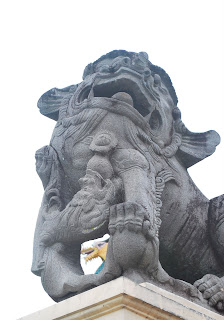Cebu City tour: the five places I went to
My trip to Cebu was just short, too short. I want to go back there as a tourist and not as a conference participant so I could explore this historic city a bit more. However, since there's a few more hours with nothing to do before the flight back to Manila, I opted to visit some of the easily accessible tourist spots in Cebu City aside from spending time in the mall.
Fe made a list of Cebu's must-sees. All we had to do was prioritise which ones we'd be able to see and then find out how to get there. Tita Dory was tied up with other activities related to the congress. Tita Ruby opted not to join us. In the end, we saw five tourist spots.
Magellan's Cross
The chapel where the cross is at can be found in front of the Cebu City Hall. There were a lot of tourists there when we dropped by along with people praying. I had to remember that this spot is also a holy place and not just a tourist spot; to make sure that I didn't disturb the devotees.
Anyway, it is said that this cross was the one that Ferdinand Magellan, the Portuguese explorer who "discovered" the Philippines, planted on the shores of Cebu in 1521. The original cross is believed to be inside the big cross visible to the tourists. The cross has been in that chapel since 1834. On the ceiling of the chapel are paintings of the scenes about the first mass in the Philippines.
 |
| chapel often visited by tourists |
 |
| Magellan's Cross |
Basilica Minore del Santo Nino
This church, which houses what may be the oldest religious image/ statue in the Philippines, is just a few metres from Magellan's Cross. The structure has baroque designs, just like Spanish-era churches in Luzon. At the time we arrived, a mass was being celebrated on the open space in front of the basilica minore. I suspect that during the Sinulog Festival, which honours the Santo Nino (Child Jesus), this open area is filled with people, both locals and tourists.
 |
| Holy Mass celebrated in the open air space |
 |
| Statues of saints watching over church goers |
 |
| altar of the basilica minore |
Cebu Metropolitan Cathedral
Still close to Magellan's Cross is the Cebu Cathedral. Church goers here are welcomed into the church by temple guardians, statues of stylised Chinese lions located right by the door. I was surprised to see that a mass was also being celebrated here concurrent to the mass at the basilica.
However, the crowd here was a lot smaller than at the basilica. There's even a parking lot around the church. A statue of Christ guarding a golden crown is seen at the garden in front of the cathedral where two pillars also stand. I'm not sure what these are supposed to be, but they sure look ancient.
Just across the street from the cathedral is Plaza Hamabar. Interestingly, this plaza has an obelisk (a symbol often used by Masons) close to the church. But what caught my interest was the statue of Rajah Humabon, who had welcomed Magellan and his group into the island and had converted to Christianity on the first mass in the Philippines.



Fort San Pedro
After seeing the cathedral, we decided to go back to the hotel to start prepping for check out. However, on the way to the jeep stop, I noticed that there looked like an interesting spot just a corner off the jeep stop. Since we were already close by, it might be worthwhile to check it out; if it's just some park, we'd leave. It turned out to be the Fort San Pedro that was crossed off the list because it seemed too far away from the rest of the spots.
It's said to be smallest and the oldest fort built by the Spaniards in the Philippines. Today, it's been developed into a garden just like Fort Santiago in Intramuros, Manila. Actually, the thick walls of the fort were the ones that made me notice it from afar.
I was just a bit disappointed to see that the three corners now don't look out to water. There might have been some reclamation work that took place. The old cannons are now pointing to construction equipment and to buildings.
Taoist Temple
Cebu City has a significant Chinese population. This is evident because there is a big Taoist temple open to the public in the Beverly Hills are of the city. To reach the temple, one has to walk more than 50 steps up a long flight of stairs. All that climbing was worth it though because the view of the city from there was great. Dennis and Cristy joined us on our visit to the temple.
Beyond being a viewing deck, the Taoist temple also gives a look at the Chinese culture. Practitioners of Taoism pray at this temple, so visitors are reminded to keep silent and to respect the temple and its rituals. For instance, worshippers go here to ask their gods or their saints a question. They first wash their hands as a sign of purity, then they light joss sticks which they stick onto the metal jar. After that, they ask their question to the gods and then throw two kidney-bean shaped wooden blocks to the floor. The gods' answer is indicated by the position of the blocks.
Cebu still has a lot to offer. I have got to come back to see the rest of the city and the province. It has such a rich culture and a long history that a half-day walking tour is not enough to see it all.









Comments
Post a Comment
Thank you for dropping by!
Before moving on, please share your thoughts or comments about the post. :)
Thanks again!